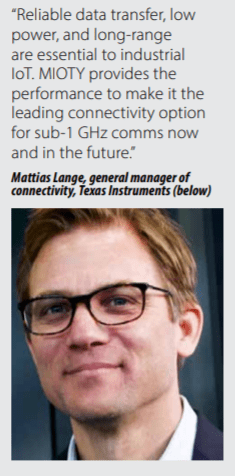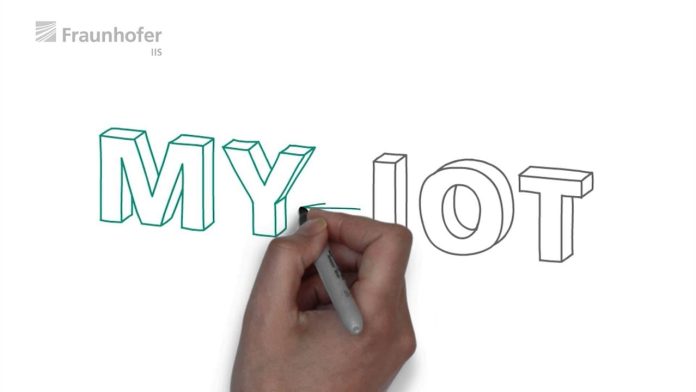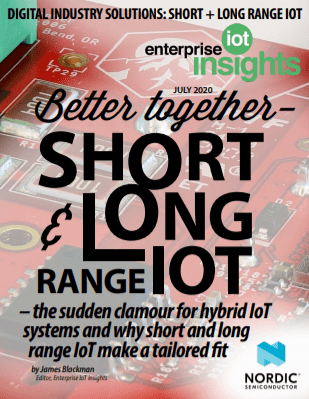Note, this article is taken from a new Enterprise IoT Insights editorial report, out tomorrow, on the combination of low-power short- and long-range communications technologies in hybrid IoT systems (see cover image below). Go here for the full report, which is free to download. The article borrows from previous MIOTY coverage (see here and here). A webinar on the same hubrid IoT, with panellists from ABI Research, the Bluetooth SIG, Nordic Semiconductor, Sigfox, and The Things Network, is available here.
There is a new challenger in the somewhat crowded low-power wide-area (LPWA) networking market, which has so far stood-up large parts of the IoT sector on the promise of cheap and long-lasting industrial sensors that have the potential to bring insight and intelligence to industrial operations, even in remote climes.
MIOTY (a portmanteau of MY IOT) uses the recent telegram-splitting ultra-narrowband (TS-UNB) specification from the European Telecommunications Standards Institute (ETSI), developed to replace the Wireless Meter Bus (M-Bus) standard that has underpinned smart metering in Europe, as well as in certain markets in Asia and Latin America.
The technology affords improved performance compared with rival LPWA technologies, including LoRaWAN and NB-IoT, plus narrowband Sigfox, according to its authors. A band of research organisations and industrial companies have just formed the MIOTY Alliance to promote MIOTY as an alternative to these better-established LPWA technologies.
 The alliance has been formed by the Fraunhofer Institute for Integrated Circuits (IIS), which helped to standardise TS-UNB. It is joined by US chip vendor Texas Instruments, German technology firm Diehl, German industrial automation company ifm, Austrian oil-and-gas technology provider Ragsol, German embedded connectivity provider Stackforce, and UK-based industrial sensor maker WIKA.
The alliance has been formed by the Fraunhofer Institute for Integrated Circuits (IIS), which helped to standardise TS-UNB. It is joined by US chip vendor Texas Instruments, German technology firm Diehl, German industrial automation company ifm, Austrian oil-and-gas technology provider Ragsol, German embedded connectivity provider Stackforce, and UK-based industrial sensor maker WIKA.
Toronto-based industrial IoT connectivity provider BehrTech, which already licenses the technology, and has built a MYTHINGS family of hardware and software solutions around it, is also involved. The alliance has proclaimed the superiority of MIOTY / TSUNB in terms of its “scalability, reliability, mobility, energy efficiency, and flexibility”.
Michael Schlicht, deputy chairman of the board at the MIOTY Alliance, comments: “MIOTY technology is a game changer that provides the required scalability, data integrity and energy efficiency for verticals such as industrial IoT or smart cities. With MIOTY the traditional LPWA network solutions, which suffer from very limited suitability for massive IoT-deployments, can reliably be complemented or replaced.”
Mattias Lange, general manager of connectivity at Texas Instruments, says: “Reliable data transfer, low power and long-range networks are essential to creating industrial IoT applications at scale. The MIOTY standard provides these components and the performance to secure its position as the leading connectivity option for worldwide sub-1 GHz communication now and in the future.”
TS-UNB splits the data packets to be transported in the data stream into small sub-packets at the sensor level. These sub-packets are then transmitted over fluctuating frequency and time. An algorithm in the base station permanently scans the spectrum for MIOTY sub-packets and reassembles them into a complete message. The fact the MIOTY is based on a standard, from ETSI, makes industrial IoT solutions easily scalable.
A single MIOTY gateway, running on commodity gateways and transceivers, can scale to handle up to 100,000 sensor nodes and – according to a recent study by the Nuremberg Institute of Technology – around 1.5 million messages per day.
MIOTY sensors operating in license-free sub-gigahertz spectrum work within a radius of up to 15 kilometres of the gateway, according to the study, depending on the geographical density – even in inhospitable environments such as mines and refineries, it says. Plus, there are no network fees.
Schlicht says: “The lack of standards has been a primary barrier to worldwide industrial IoT scalability. We worked closely with globally-recognised standards body ETSI to introduce this revolutionary technology to the market.”
BehrTech says MIOTY / TS-UNB is better than any of the cellular or non-cellular LPWA offerings currently available for industrial applications. It has issued a separate report that takes aim at LoRaWAN, specifically, on the grounds it is more robust in “real-world industrial environments” with high levels of interference from other systems and devices.
BehrTech’s MYTHINGS-branded software platform and sensing products, using the MIOTY standard, can be “easily” retrofitted to industrial setups, the company claims. Customers are yet to be announced, but it has “real-world mining use cases”, it says, and is gaining traction in other industrial sectors besides. It has so far confirmed partnerships with Microsoft, Advantech, and Hitachi, among others.
Adarsh Krishnan, principal analyst at ABI Research, observes the technology is brand new, and the market is busy already. “MIOTY offers better coverage and capacity to manage high densities of end-devices, and is positioned as a successor to Wireless M-Bus in the utility market, and in other industrial IoT use-cases,” he says.
“However, MIOTY is still in very early stages of market development. We are yet to see wider industry adoption. Finally, as LPWA technologies such as Sigfox, LoRaWAN, NB-IoT, and LTE-M continue to rapidly expand their public network coverage footprints, it will be interesting to see how MIOTY differentiates itself, or whether it will be limited to private network deployments addressing smart metering and industrial ioT applications.


